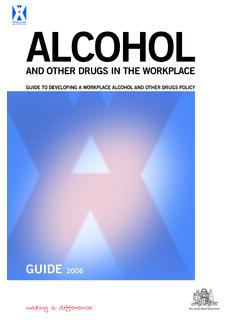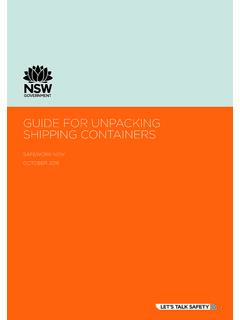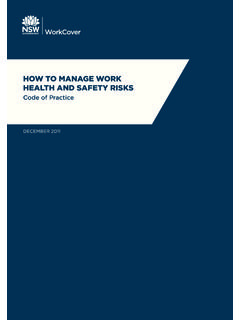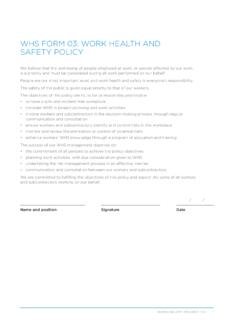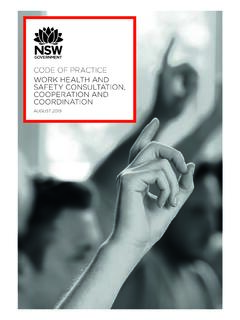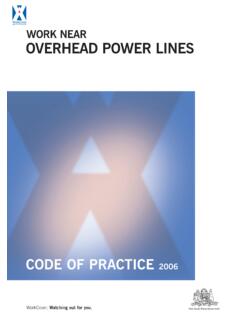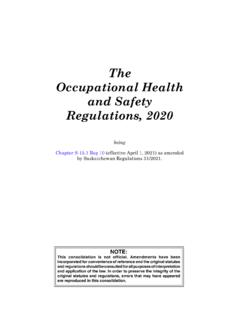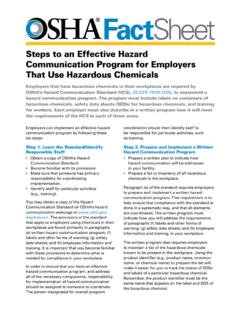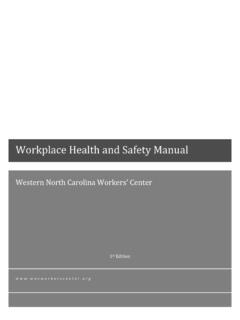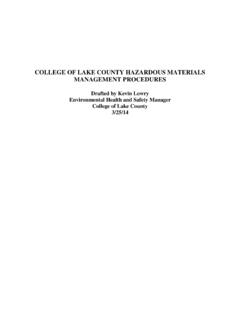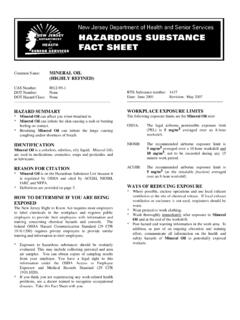Transcription of Managing Risks of Hazardous Chemicals in the Workplace
1 CODE OF PRACTICEMANAGING Risks OF Hazardous Chemicals IN THE WORKPLACEAUGUST 2019 NSW note: This code is based on a national model code of practice developed by Safe Work Australia under the harmonisation of national work health and safety legislation and has been approved under section 274 of the NSW Work Health and Safety Act 2011. Notice of that approval was published in the NSW Government Gazette referring to this code of practice as Managing Risks of Hazardous Chemicals in the Workplace (page 2695) on Friday 18 July 2014. This code of practice commenced on Friday 18 July amendments under section 274 of the NSW Work Health and Safety Act 2011 have been published and commenced as detailed in the list of amendments contained in this for the NSW Government logo, this copyright work is licensed under a Creative Commons Attribution-Non-Commercial Australia view a copy of this licence, visit are free to copy, communicate and adapt the work for non-commercial purposes, as long as you attribute the work to SafeWork NSW and abide by the other licence terms.
2 Contents Foreword .. 5 1. Introduction .. 7 What are Hazardous Chemicals ? .. 7 Who has health and safety duties in relation to Hazardous Chemicals ? .. 8 What is required to manage the Risks associated with Hazardous Chemicals ? .. 10 Prohibited and restricted Hazardous 12 Exposure standards .. 12 Preparing a register and manifest of Hazardous Chemicals .. 13 2. Identifying hazards .. 15 How to identify which Chemicals are Hazardous .. 15 Safety Data Sheets (SDS) .. 16 Labels .. 18 Other sources of information .. 20 3. The risk management process .. 21 Decide who should do the assessment.
3 21 Decide what sort of risk assessment is appropriate .. 22 Things to consider in assessing health Risks .. 24 How to assess physical Risks .. 27 4. Controlling Risks .. 33 The hierarchy of control measures .. 33 Specific control measures .. 40 Maintaining control measures .. 45 Providing information, training, instruction and supervision .. 46 5. Monitoring and review .. 49 Health monitoring .. 49 Reviewing control measures .. 50 6. Emergency preparedness .. 52 Emergency plan .. 52 Emergency equipment and safety equipment .. 54 Fire protection systems .. 55 Monitors and alarms .. 56 Automatic sprinkler systems.
4 56 Water supply .. 57 Appendix A Glossary .. 58 Appendix B Comparison of hazard classes and categories under the ADG Code and the GHS .. 62 Managing Risks of Hazardous Chemicals in the Workplace Code of Practice Page 4 of 114 Appendix C Prohibited carcinogens, restricted carcinogens and restricted Hazardous Chemicals .. 65 Appendix D Placard and manifest quantities .. 69 Appendix E Requirements for health monitoring .. 77 Appendix F Overview of a risk assessment process .. 80 Appendix G Risk assessment checklist .. 81 Appendix H Examples of common fuel and oxygen sources .. 83 Appendix I Fire and explosion Risks .
5 85 Appendix J Practical examples of control measures .. 89 Appendix K Case studies .. 96 Amendments .. 113 Managing Risks of Hazardous Chemicals in the Workplace Code of Practice Page 5 of 114 Foreword This Code of Practice on how to manage the Risks associated with Hazardous Chemicals in the Workplace is an approved code of practice under section 274 of the Work Health and Safety Act (the WHS Act). An approved code of practice provides practical guidance on how to achieve the standards of work health and safety required under the WHS Act and the Work Health and Safety Regulation (the WHS Regulation) and effective ways to identify and manage Risks .
6 A code of practice can assist anyone who has a duty of care in the circumstances described in the code of practice. Following an approved code of practice will assist the duty holder to achieve compliance with the health and safety duties in the WHS Act and WHS Regulation, in relation to the subject matter of the code of practice. Like regulations, codes of practice deal with particular issues and may not cover all relevant hazards or Risks . The health and safety duties require duty holders to consider all Risks associated with work, not only those for which regulations and codes of practice exist. Codes of practice are admissible in court proceedings under the WHS Act and WHS Regulation.
7 Courts may regard a code of practice as evidence of what is known about a hazard, risk, risk assessment or risk control and may rely on the code in determining what is reasonably practicable in the circumstances to which the code of practice relates. For further information see the Interpretive Guideline: The meaning of reasonably practicable . Compliance with the WHS Act and WHS Regulation may be achieved by following another method if it provides an equivalent or higher standard of work health and safety than the code. An inspector may refer to an approved code of practice when issuing an improvement or prohibition notice.
8 Scope and application This Code is intended to be read by a person conducting a business or undertaking (PCBU). It provides practical guidance to PCBUs on how to manage health and safety Risks associated with Hazardous Chemicals used in their Workplace . A PCBU can be a manufacturer, importer or supplier of Hazardous Chemicals , or a business owner who uses, handles, generates or stores Hazardous Chemicals at their Workplace . They may also be more than one of these things. This Code may be a useful reference for other persons interested in the duties under the WHS Act and WHS Regulation. This Code applies to all types of work and all workplaces covered by the WHS Act.
9 This Code applies to: substances, mixtures and articles used, handled, generated or stored at the Workplace which are defined as Hazardous Chemicals under the WHS Regulation the generation of Hazardous Chemicals from work processes, for example toxic fumes released during welding. This Code does not apply to the transportation of dangerous goods or explosives which are subject to state and territory laws based on the requirements under the Australian Code for the Transport of Dangerous Goods by Road and Rail (ADG Code) and the Australian Code for the Transport of Explosives by Road and Rail 3rd edition.
10 Most substances and mixtures that are dangerous goods under the ADG Code are also Hazardous Chemicals . Any person Managing Risks of Hazardous Chemicals in the Workplace Code of Practice Page 6 of 114 conducting a business or undertaking (PCBU) has a responsibility under WHS laws to manage the Risks from Hazardous Chemicals , including those that are also dangerous goods. Manufacturers, importers or suppliers of Hazardous Chemicals that are used, or are likely to be used, in workplaces should refer to the following Codes of practice: Preparation of safety data sheets (SDS) for Hazardous Chemicals , and Labelling of Workplace Hazardous Chemicals .
